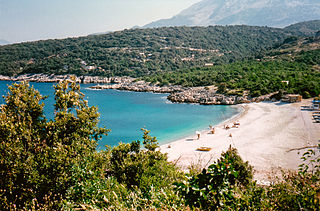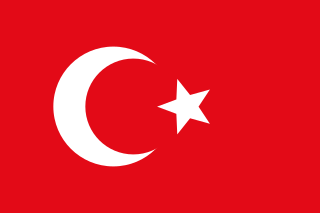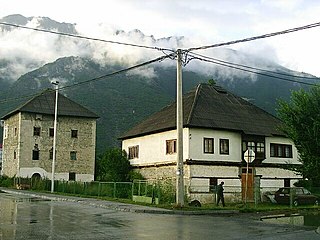
Sandžak is a historical and geo-political region in the Balkans, located in the southwestern part of Serbia and the eastern part of Montenegro. The Serbo-Croatian term Sandžak derives from the Sanjak of Novi Pazar, a former Ottoman administrative district founded in 1865.

Metohija, also known in Albanian as Dukagjin is a large basin and the name of the region covering the southwestern part of Kosovo. The region covers 35% (3,891 km2) of Kosovo's total area. According to the 2024 census, the population of the region is 570,147.

Struga is a town and popular tourist destination situated in the south-western region of North Macedonia, lying on the shore of Lake Ohrid. The town of Struga is the seat of Struga Municipality.

Junik is a town and municipality in the Gjakova District in western Kosovo.
Albanians in Montenegro are ethnic Albanians who constitute 4.97% of Montenegro's total population. They belong to the ethnic Albanian sub-group of Ghegs, and they are the largest non-Slavic ethnic group in Montenegro.

Margariti is a village and a former municipality in Thesprotia, Epirus, Greece. Since the 2011 local government reform it is part of the municipality Igoumenitsa, of which it is a municipal unit. The municipal unit has an area of 149.223 km2. Population 1,931 (2021).

Kuči is a tribe of Albanian origin, historically located in modern central and eastern Montenegro, north-east of Podgorica, extending along the border with Albania. Processes of Slavicisation during the Ottoman era and onwards facilitated ethno-linguistic shifts within much of the community. As such, people from the Kuči today largely identify themselves as Montenegrins and Serbs, with a minority still identifying as Albanians. In other areas such as the Sandžak, many Muslim descendants of the Kuči today identify as Bosniaks.

Mrkojevići is a historical region in southwestern Montenegro, located between the towns of Bar and Ulcinj. The region borders Krajina to the east. The Mrkojevići form a distinct ethno-geographical group with their own dialect of the Serbo-Croatian language, while also exhibiting a degree of bilingualism in Albanian. Their customs are distinct from their neighbouring Slavic and Albanian communities, but they also show influence and contacts with them. In the 400-year Ottoman period, the Mrkojevići converted to Islam, which forms an important aspect of their cultural identity.

Bjelopavlići is a historical tribe (pleme) of Albanian origin and a valley in the region of the Brda, in Montenegro, around the city of Danilovgrad.

The Vallahades or Valaades are a Greek-speaking Muslim population who lived along the river Haliacmon in southwest Greek Macedonia, in and around Anaselitsa and Grevena. They numbered about 17,000 in the early 20th century. They are a frequently referred-to community of late-Ottoman Empire converts to Islam, because, like the Cretan Muslims, and unlike most other communities of Greek Muslims, the Vallahades retained many aspects of their Greek culture and continued to speak Greek for both private and public purposes. Most other Greek converts to Islam from Macedonia, Thrace, and Epirus generally adopted the Ottoman Turkish language and culture and thereby assimilated into mainstream Ottoman society.

Opolje is a region in the southern part of the municipality of Prizren in southern Kosovo. The region has 19 villages mainly inhabited by Kosovo Albanians.

Shkreli is a historical Albanian tribe and region in the Malësia Madhe region of northern Albania and is majority Catholic. With the expansion of the Ottoman Empire, part of the tribe migrated to Rugova in Western Kosovo beginning around 1700, after which they continued to migrate into the Lower Pešter and Sandžak regions.

Dropull is a municipality in Gjirokastër County, in southern Albania. The region stretches from south of the city of Gjirokastër to the Greek–Albanian border, along the Drino river. The region's villages are part of the Greek "minority zone" recognized by the Albanian government, in which majorities of ethnic Greeks live.

The Sanjak of Scutari or Sanjak of Shkodra was one of the sanjaks of the Ottoman Empire. It was established after the Ottoman Empire acquired Shkodra after the siege of Shkodra in 1478–9. It was part of the Eyalet of Rumelia until 1867, when it became a part, together with the Sanjak of Skopje, of the newly established Scutari Vilayet. In 1912 and the beginning of 1913 it was occupied by members of the Balkan League during the First Balkan War. In 1914 the territory of Sanjak of Scutari became a part of the Principality of Albania, established on the basis of the peace contract signed during the London Conference in 1913.

The Sanjak of Delvina was one of the sanjaks of the Ottoman Empire which county town was Delvinë but during the 18th century became Gjirokastër, Albania. It was created in the mid-16th century, came under the control of the Pashalik of Yanina during 1785−1822, and was disestablished after the Balkan Wars in 1913. It was divided between Albania Albania and Greece in 1913.

Janjevo or Janjevë is a village or small town in the Lipjan municipality in eastern Kosovo.

Has is a region in north eastern Albania and south western Kosovo.

Gusinje Municipality is a municipality in northern Montenegro. It is located in the upper Lim valley at an elevation of about 1,000 m (3,000 ft). It was created in 2014, when it split from Plav Municipality. Its center is the small town of Gusinje, and its biggest village in terms of territory is Vusanje. Two of Montenegro's highest mountains overlook Gusinje: Zla Kolata and Visitor. Many of Gusinje's settlements are historically linked with the Albanian Kelmendi tribe (fis). The village of Gusinje developed into a town the 17th century around a fortress built by the Ottomans to contain the Kelmendi. In the 19th century, Gusinje was a developing regional market center. It was engulfed in 1879–1880 in a struggle between the Principality of Montenegro that wanted to annex it and the League of Prizren that opposed it. After the Balkan Wars, Gusinje became part of Montenegro and in 1919 part of Yugoslavia. Today, it is part of Montenegro since its declaration of independence in 2006.
The Islamization of Albania occurred as a result of the Ottoman conquest of the region beginning in 1385. The Ottomans through their administration and military brought Islam to Albania.

Burmazi was an Albanian tribe which is attested in Herzegovina in the Middle Ages.
















